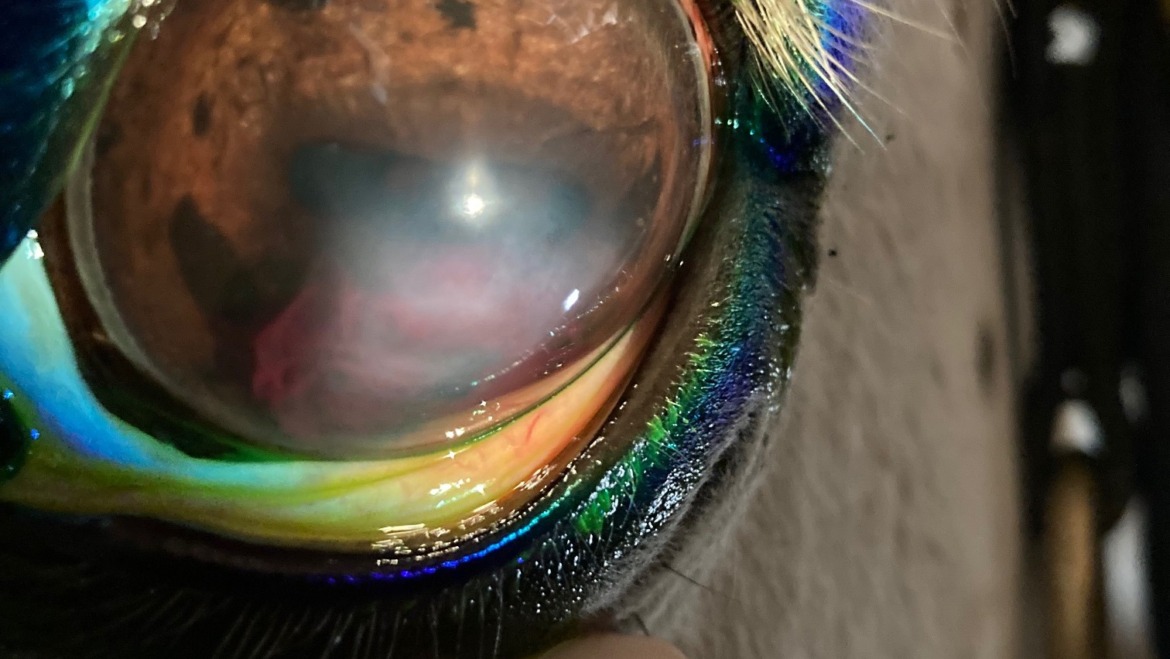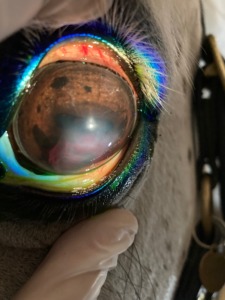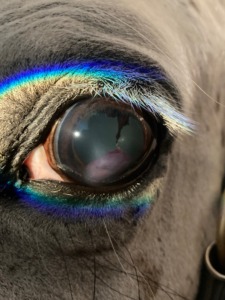August Case of the Month: Eye See a Problem
Cherry is a 14-year-old Gypsy Vanner mare used as a therapy horse. She was diagnosed with uveitis – inflammation within the eye – this spring. She was being managed well with steroid drops into her affected eye to control the inflammation until she traumatized her eye early in the summer and reaggravated the inflammation. As a result of the trauma to her eye, Cherry had developed hyphema (blood within the anterior chamber of her eyeball), as well as corneal edema (swelling of the cornea), and her pupil was miotic (tightly constricted).
Blood within the eye (hyphema) is not itself damaging, but rather is a symptom of either trauma or some other abnormal process within the eye. The most common cause of hyphema in horses is blunt trauma to the eye – getting kicked, or running into something – but it can also develop from masses growing within the eye, severe recurrent uveitis, and blood disorders. The blood clot within the eyeball typically takes 2-3 weeks to completely break down and be reabsorbed by the body.
Corneal edema appears as a blue-greyish haze over the surface of the eye and is the result of swelling within the cornea. This fluid within the cornea turns the normally transparent tissue opaque, resulting in the haze. While corneal edema does reduce the horse’s vision when it is present, it is not harmful but rather it is an indicator of inflammation. Corneal edema is typically seen with corneal ulcers or uveitis.
Miotic pupils occur as a response to pain and inflammation within the eye. The oblong ring muscle of the iris which normally controls the opening diameter of the pupil, can develop a spasm in response to inflammation and pain signals within the eyeball. The spasm in the iris, much like a charley horse in your thigh or calf muscle, is also very painful for the horse and furthers the spiral of pain and inflammation within the eye. To break this pain and muscle spasm cycle, we treat horses with miotic pupils with a topical form of atropine directly onto their eye. The atropine relaxes the iris muscle, allowing the pupil to dilate again and removing that added source of pain for the horse.
Cherry responded well to her treatment of topical steroids for the inflammation in her eye, topical atropine for her miotic pupil, and systemic anti-inflammatories. The hyphema she sustained from the trauma was gradually reabsorbed and her eye is no worse for wear now. Cherry does continue to be treated with a preventative dose of the topical steroids to keep her uveitis at bay, and when she has inflammatory flare ups she is treated with additional medications to keep her comfortable and prevent her from traumatizing the eye once again.
- Photo 1 shows the hazy patch of corneal edema over top of the hyphema (blood clot) and the very narrow, miotic pupil is visible behind the edema.
- Photo 2 shows the now dilated pupil after administering atropine to the eye and the large blood clot which has adhered to a portion of her corpora nigra and is pulling a string of it towards the bottom of the eye under the weight of the blood clot.



